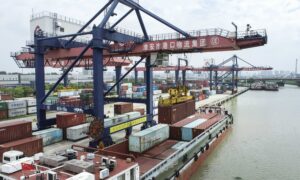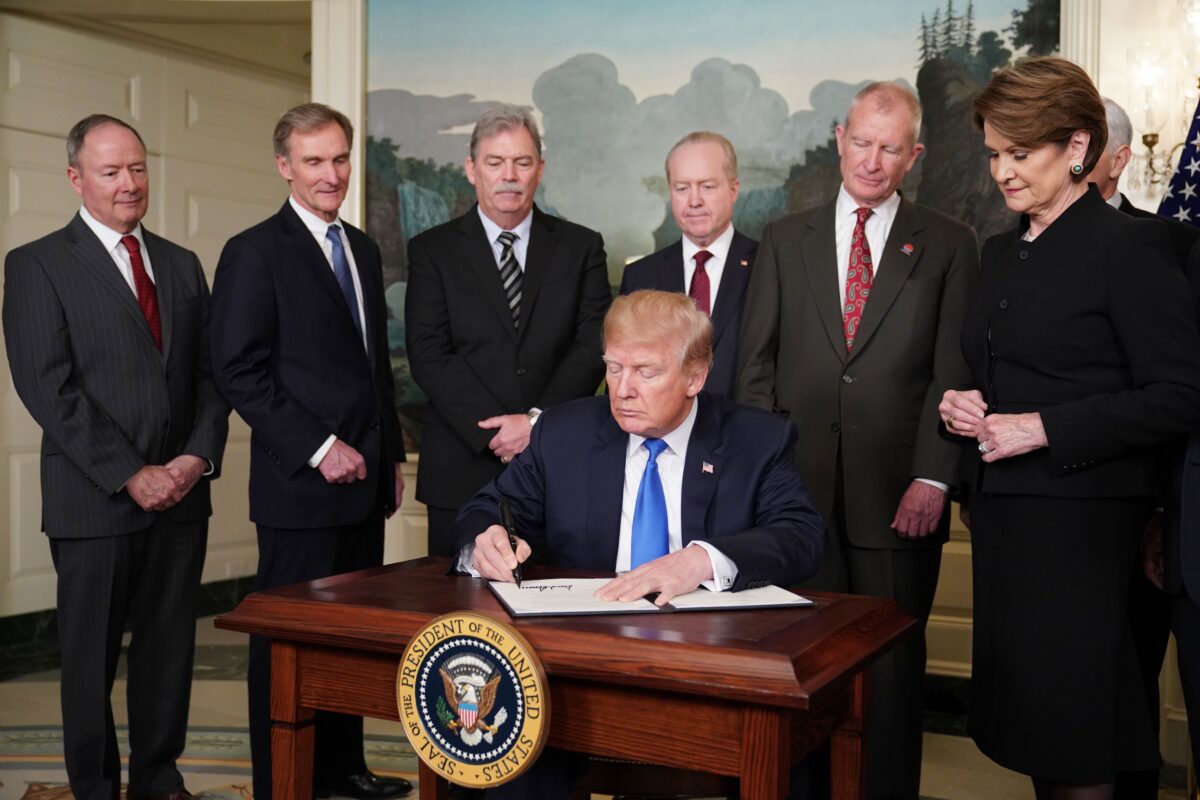US-China Trade Has Turned Down Sharply
CommentaryWashington has made no secret of its desire to decouple the U.S. economy from China trade—if not completely, then certainly significantly. Recent data shows that the process is proceeding pretty much as Washington wants. Flows of Chinese goods to the United States have fallen sharply. Of course, the decline in trade is not entirely the result of Washington’s wishes, much less the raft of recent legislation aimed at curtailing America’s involvement in China. The global economic slowdown, as well as the lockdowns associated with Beijing’s zero-COVID policy, have also played a big part in the trade downturn, likely a bigger part than Washington’s policies. Whatever the mix of influences, the trend is significant. Recent data make matters crystal clear. As of November, American orders for Chinese manufactured goods have declined some 40 percent from their highs of August, a remarkable turn in the space of just three months. Actual shipment volumes have declined by less but still a steep 21 percent. Perhaps more telling are reports from the U.S. West Coast ports, where most Chinese goods land in North America. Their levels of activity stand at their lowest in 27 months. Volumes in November were 63.6 percent below May’s recent highs. Against such news, it is hardly surprising that Chinese factories have scheduled earlier closedowns for the Chinese New Year, some two to three weeks earlier, in fact. Forecasters anticipate further declines. Goldman Sachs, for example, anticipates a 2.0 percent drop in export volumes overall in 2023, but that seems too moderate, given how much further U.S. export orders have already fallen. These clear decoupling trends are perhaps even clearer in sourcing figures from American businesses. Last month, for the first time in a long time, the United States imported more from Europe than from Asia. German exports to the United States rose almost 43 percent between last January and October, the most recent month for which data are available. Washington certainly has worked hard to get results like these. President Joe Biden, despite harsh past criticism of his predecessor’s China policy, has kept all the Trump tariffs on Chinese imports in place. This may speak to Washington’s attitude, but since the tariffs have been in place for years now, they can hardly account for recent, sharp declines in shipments and orders. Nor could the recent legislation account for the change in trade. True, Congress has passed laws that subsidize the domestic production of computer chips, electric vehicles, and lithium batteries, all of which have constituted a major part of U.S. imports from China. But it is too soon for those incentives to have had an effect. Then-U.S. President Donald Trump signed trade sanctions against China in the Diplomatic Reception Room of the White House in Washington on March 22, 2018. (Mandel Ngan/AFP via Getty Images) Instead of legislation, the decline in orders and shipments seems to have its roots largely in the softening of the U.S. economy. The slowdown in American sales and production activity generally has been marked. Some observers have declared that the economy is already in recession. If anything, Europe is suffering an even more pronounced slowdown and may already be in a recession. What is more, the rise in interest rates throughout the Western world, though intended to combat inflation, will nonetheless weigh on economic activity. Real estate and home building on both sides of the Atlantic have already suffered sharp declines. As the effect of these rate increases spreads, economies will slow even further and, if not already in recession, will suffer one in 2023. The anticipation of just such an effect is no doubt why orders for Chinese goods have fallen much farther than shipments. On another, more fundamental level is the reaction to Chinese behavior during the COVID-19 pandemic and in the initial stages of the post-COVID recovery. During the pandemic, Beijing withheld shipments of needed supplies, such as face masks. It is certainly understandable why Beijing held such products back for domestic use. Still, the behavior left American buyers with the sense that Chinese sourcing was perhaps less reliable than they had thought. Such suspicions received confirmation as lockdowns of Beijing’s zero-COVID policy created supply chain problems for months as the West began its post-pandemic recovery. These experiences created a widespread sense among American business managers that the prudent path would be to diversify their sourcing away from China to other places in Asia and elsewhere. Apple’s recent decision to relocate some of its iPhone and iPad assembly away from China to India and Vietnam stands as only the most prominent sign of what is happening more generally. As some of these more cyclical considerations abate, Washington’s determination to decouple the U.S. economy from China’s will reinforce the memories of China’s past lack of reliabil

Commentary
Washington has made no secret of its desire to decouple the U.S. economy from China trade—if not completely, then certainly significantly. Recent data shows that the process is proceeding pretty much as Washington wants.
Flows of Chinese goods to the United States have fallen sharply. Of course, the decline in trade is not entirely the result of Washington’s wishes, much less the raft of recent legislation aimed at curtailing America’s involvement in China. The global economic slowdown, as well as the lockdowns associated with Beijing’s zero-COVID policy, have also played a big part in the trade downturn, likely a bigger part than Washington’s policies. Whatever the mix of influences, the trend is significant.
Recent data make matters crystal clear. As of November, American orders for Chinese manufactured goods have declined some 40 percent from their highs of August, a remarkable turn in the space of just three months. Actual shipment volumes have declined by less but still a steep 21 percent.
Perhaps more telling are reports from the U.S. West Coast ports, where most Chinese goods land in North America. Their levels of activity stand at their lowest in 27 months. Volumes in November were 63.6 percent below May’s recent highs. Against such news, it is hardly surprising that Chinese factories have scheduled earlier closedowns for the Chinese New Year, some two to three weeks earlier, in fact. Forecasters anticipate further declines. Goldman Sachs, for example, anticipates a 2.0 percent drop in export volumes overall in 2023, but that seems too moderate, given how much further U.S. export orders have already fallen.
These clear decoupling trends are perhaps even clearer in sourcing figures from American businesses. Last month, for the first time in a long time, the United States imported more from Europe than from Asia. German exports to the United States rose almost 43 percent between last January and October, the most recent month for which data are available.
Washington certainly has worked hard to get results like these. President Joe Biden, despite harsh past criticism of his predecessor’s China policy, has kept all the Trump tariffs on Chinese imports in place. This may speak to Washington’s attitude, but since the tariffs have been in place for years now, they can hardly account for recent, sharp declines in shipments and orders. Nor could the recent legislation account for the change in trade. True, Congress has passed laws that subsidize the domestic production of computer chips, electric vehicles, and lithium batteries, all of which have constituted a major part of U.S. imports from China. But it is too soon for those incentives to have had an effect.

Instead of legislation, the decline in orders and shipments seems to have its roots largely in the softening of the U.S. economy. The slowdown in American sales and production activity generally has been marked. Some observers have declared that the economy is already in recession. If anything, Europe is suffering an even more pronounced slowdown and may already be in a recession.
What is more, the rise in interest rates throughout the Western world, though intended to combat inflation, will nonetheless weigh on economic activity. Real estate and home building on both sides of the Atlantic have already suffered sharp declines. As the effect of these rate increases spreads, economies will slow even further and, if not already in recession, will suffer one in 2023. The anticipation of just such an effect is no doubt why orders for Chinese goods have fallen much farther than shipments.
On another, more fundamental level is the reaction to Chinese behavior during the COVID-19 pandemic and in the initial stages of the post-COVID recovery. During the pandemic, Beijing withheld shipments of needed supplies, such as face masks. It is certainly understandable why Beijing held such products back for domestic use. Still, the behavior left American buyers with the sense that Chinese sourcing was perhaps less reliable than they had thought. Such suspicions received confirmation as lockdowns of Beijing’s zero-COVID policy created supply chain problems for months as the West began its post-pandemic recovery.
These experiences created a widespread sense among American business managers that the prudent path would be to diversify their sourcing away from China to other places in Asia and elsewhere. Apple’s recent decision to relocate some of its iPhone and iPad assembly away from China to India and Vietnam stands as only the most prominent sign of what is happening more generally.
As some of these more cyclical considerations abate, Washington’s determination to decouple the U.S. economy from China’s will reinforce the memories of China’s past lack of reliability so that the trend away from Chinese sourcing will almost certainly continue into 2023 and even 2024, less sharply perhaps than in the past few months but in the same downward direction. Accordingly, China’s economy will grow at a slower pace than in the past.
Views expressed in this article are the opinions of the author and do not necessarily reflect the views of The Epoch Times.












